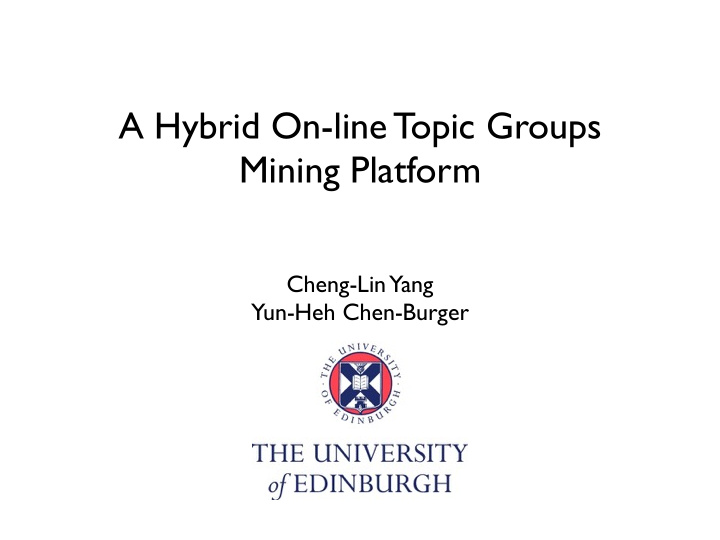



A Hybrid On-line Topic Groups Mining Platform Cheng-Lin Yang Yun-Heh Chen-Burger
Target � Given a large set of tweets, identify all possible topics of each tweet and cluster tweets with similar topics into communities.
Problems we face � Unstructured Data ¤ Big data ¤ Multiple users conversations ¤ Uncontrolled topic threads ¤ Up-to-date topic ¤ Short content with little reference or information ¤ Noise ¤ emoticons: Orz / :) / :D ¤ Internet slang: LOL / BRB ¤ Meaningless strings: !@#%!!
Proposed Framework
Proposed Method Overview Wikipedia Process dump Storage Topic Enriching Tweets Clustering Identification Documents Result
Anchor Identification � What is Anchor in Wikipedia
Anchor Identification � Why Anchor is useful? ¤ We define that an Anchor is a topic in Wikipedia ¤ It is defined by authors therefore is more trustworthy
Proposed Method Overview Wikipedia Process dump Storage Topic Enriching Tweets Clustering Identification Documents Result
Topic lookup � Divide the input tweet by n-gram where n=1 ~ 6 � Eg: Steve Jobs is CEO of Apple ¤ Steve, Steve Jobs, Steve Jobs is, Steve Jobs is CEO, Steve Jobs is CEO of Apple ¤ Jobs, Jobs is, Jobs is CEO, Jobs is CEO of, Jobs is CEO of apple ¤ Is, is CEO, is CEO of, is CEO of Apple ¤ CEO, CEO of, CEO of Apple ¤ of, of Apple ¤ Apple
Topic lookup � Look up all divided term in the anchor dictionary ¤ Keep all matched anchors as candidates: ■ Steve, Steve Jobs, CEO, Apple ¤ Remove the anchor which is the substring of the candidate anchor ■ Steve Jobs, CEO, Apple � Ambiguous anchor issue: ¤ Apple = apple tree apple computers apple records …..
Disambiguation � Voting for the most possible topic which is the most related to the given anchor ¤ Using Google distance to calculate the relatedness between all ambiguous topics and given anchor ¤ Calculate total score of each anchor ¤ Remove topic with lower score by threshold Apple = {Apple inc., Apple Computer} � Assign the highest commonness topic to given anchor ¤ Apple = Apple Computer
Topic filtering � Result of disambiguation ¤ Steve Jobs={Steve Jobs} ¤ CEO = {CEO} ¤ Apple = {Apple inc.} � Finally, check the coherence between selected anchors
Proposed Method Overview Wikipedia Process dump Storage Topic Enriching Tweets Clustering Identification Documents Result
Document Enrichment � Applying TF-IDF on short text documents such as tweets is usually not able to identify the important terms. Eg: “Watching on Youtube is easier and faster” TF: {watch: 1, youtube: 1, easier: 1, faster: 1} IDF: {watch: 0.35, youtube: 0.47, easier: 0.56, faster: 0.57}
Document Enrichment – Method 1 “Watching on Youtube is easier and faster” � Identified topic: youtube. Add it to the tweet “Watching on Youtube is easier and faster Youtube” TF: {watch: 1, youtube: 2, easier: 1, faster: 1} IDF: {watch: 0.26, youtube: 0.73, easier: 0.44, faster: 0.44}
Document Enrichment – Method 2 � However, Method 1 ignores that two tweets might have semantic related topics. ¤ “Flickr is awesome!” => topic: Flickr “Just in love with Shutterfly” => topic: Shutterfly ¤ Flickr and Shutterfly are both in “Photo Sharing” category in Wikipedia � Therefore, adding Wikipedia category to both tweet to increase the cosine similarity
Clustering tweets � Using Bisecting K-means
Evaluating the result � Three testing cases ¤ Baselines ¤ Adding Wikipedia topics ¤ Adding Wikipedia topics and categories � Datasets ¤ Ground (golden) truth - 20 topic groups ¤ 20 tweets for each group ¤ Testing sets ¤ ~ 1.1 million tweets (English only)
Evaluating the results � Using V-measure to evaluate the generated clusters ¤ V-measure is a evaluation functions which considers both homogeneity and completeness ¤ homogeneity: each cluster contains only members of a single class ¤ completeness: all members of a given class are assigned to the same cluster
Results
Human Experts Examination � 10 human examiners ¤ 5 groups for each examiner and 10 tweets for each group ¤ Given a generated cluster and ask the expert to rate the relevance from 1 ~ 5 ¤ 1 - Not relevant at all ¤ 2 - Maybe relevant or I’m not quite sure ¤ 3 - Slightly relevant ¤ 4 - Relevant ¤ 5 - Very relevant
Result - Baseline
Result - Baseline + Topics
Result - Baseline + Topics + Categories
Recommend
More recommend